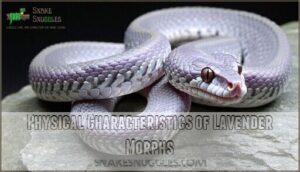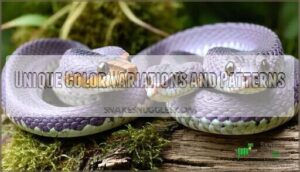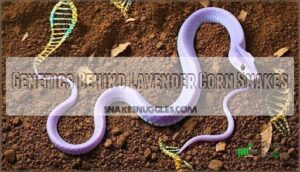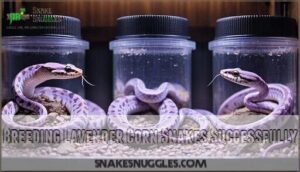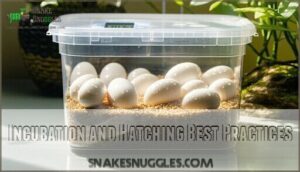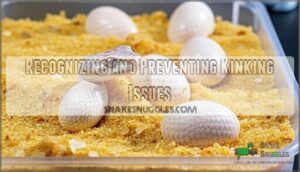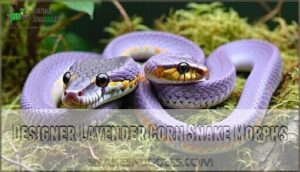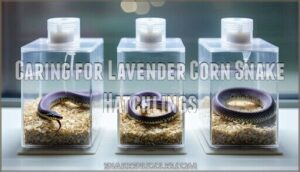This site is supported by our readers. We may earn a commission, at no cost to you, if you purchase through links.
 You’d think breeding two purple snakes would be straightforward, but lavender corn snake genetics throws a curveball. The soft purple-grey coloration comes from a recessive gene, meaning you can’t just pair any two pretty snakes and expect lavender babies.
You’d think breeding two purple snakes would be straightforward, but lavender corn snake genetics throws a curveball. The soft purple-grey coloration comes from a recessive gene, meaning you can’t just pair any two pretty snakes and expect lavender babies.
You need both parents carrying the right genetic cards—either two lavenders or a lavender paired with a het lavender that looks nothing like the morph you’re after. Understanding this recessive trait is the difference between a clutch full of surprises and one that meets your expectations.
Once you grasp the genetics, you’ll find combinations like plasma lavenders and orchid morphs that command premium prices and turn heads at reptile shows.
Table Of Contents
- Key Takeaways
- Lavender Corn Snake Traits and Coloration
- Genetics Behind Lavender Corn Snakes
- Breeding Lavender Corn Snakes Successfully
- Incubation and Hatching Best Practices
- Recognizing and Preventing Kinking Issues
- Designer Lavender Corn Snake Morphs
- Caring for Lavender Corn Snake Hatchlings
- Health and Longevity Considerations
- Market Trends and Pricing Factors
- Frequently Asked Questions (FAQs)
- How can you identify the sex of a lavender corn snake?
- What permits are required for breeding corn snakes?
- How do you find reputable lavender corn snake buyers?
- Can lavender corn snakes breed with other species?
- What records should breeders maintain for lineage tracking?
- How do you quarantine new breeding stock properly?
- Conclusion
Key Takeaways
- Lavender corn snakes require both parents to carry the recessive gene—either two visual lavenders or one lavender paired with a heterozygous carrier—to produce lavender offspring, following a 25% visual, 50% het, 25% normal ratio.
- Incubation temperature directly impacts hatchling health, with 80-81°F being optimal; temperatures above 82°F significantly increase the risk of spinal kinking, a developmental defect seen more frequently in lavender morphs.
- Designer combinations like plasma lavender, orchid (hypo lavender), and lavender tessera command premium prices ($200-$500+) due to the genetic complexity of pairing multiple recessive traits successfully.
- Proper breeding requires selecting mature, healthy pairs (females at least 300 grams, both sexes 18+ months old) and providing 8-10 weeks of brumation at 50-60°F to trigger natural reproductive cycles during the March-May breeding season.
Lavender Corn Snake Traits and Coloration
Lavender corn snakes stand out from the crowd with their soft purple-grey tones and ruby-red eyes.
You’ll notice these captive-bred morphs display a surprising range of color intensity and pattern variation.
Let’s break down what makes lavender morphs unique, from their signature physical traits to the subtle differences you’ll see between males and females.
Physical Characteristics of Lavender Morphs
Lavender corn snakes are eye-catching animals with a delicate palette that sets them apart from wild-type corns—think pale gray bodies adorned with darker purple-gray saddles and those unmistakable reddish eyes that seem to glow under the right light.
When you’re evaluating lavender corn snake appearance, pay attention to these key morphological details:
- Head patterns generally show a V-shape behind the eyes with pink blushing
- Eye coloration features deep ruby pupils surrounded by dark wine or slate gray irises
- Body shades range from pale gray backgrounds to peachy or pink undertones
- Frosting effect appears as white blotches scattered throughout the saddles
Adult lavenders develop lower contrast as they mature, with color saturation generally stronger in males than females.
Unique Color Variations and Patterns
No two lavenders are identical—some lean peachy, others stay strictly gray, and a few surprise you with unexpected brown tones that shift as they mature. Pattern inheritance plays a major role in saddle patterns, with some lavender corn snakes showing crisp, well-defined borders while others display aberrant patterns with irregular edges.
Blushing variations behind the head add warmth to otherwise cool-toned specimens, and color intensity fluctuates based on genetics—you’ll notice this especially when comparing corn snake morphs side by side during shed cycles.
Differences Between Males and Females
Males generally show richer color saturation than females, a difference you can spot most clearly once they reach breeding size—though sexing by color alone isn’t reliable until you compare mature specimens side by side.
Here’s what else separates them:
- Body Size – Females grow longer overall, but males develop thicker builds once breeding maturity hits.
- Tail Length – Males have longer, gradually tapering tails; females taper more abruptly past the vent.
- Temperament Differences – Males often display more active behavior during breeding season due to hormone shifts.
- Genetics – Both sexes carry the recessive lavender trait equally, so breeding outcomes depend on paired genetics, not sex.
- Related Traits – Color saturation differences don’t affect snake breeding success—focus on health and lineage instead.
Genetics Behind Lavender Corn Snakes
Lavender genetics go deeper than color—what matters is how the trait moves through your breeding lines.
Since lavender is recessive (unlike dominant morphs), you’ll need a game plan if you want to produce it.
Here’s the deal: we need to understand how this recessive gene functions, what’s required to produce lavender babies, and how it stacks with other traits like scaleless.
Recessive Nature of The Lavender Gene
Think of recessive traits as a genetic combo lock—both tumblers need to click into place. Lavender corn snakes owe their soft, muted coloring to a recessive mutation in the LYST gene, which means a snake needs two copies of the altered allele to actually look lavender.
Breed two carriers together, and the math plays out predictably: you’ll get 25% lavender babies, 50% that carry the gene without showing it, and 25% standard wild-type.
Understanding recessive traits is like unlocking a puzzle—you need two matching pieces. The lavender corn snake gets its signature look from a recessive mutation in the LYST gene, requiring two defective alleles to show the phenotype. When you cross two carriers, you’ll see classic Mendelian ratios: 25% lavender offspring, 50% carriers, and 25% wild-type.
The lavender color was first produced in 1985. Genotype validation through SNP analysis confirms this pattern across breeding lines, making carrier identification straightforward for anyone serious about lavender corn snake breeding and understanding snake genetics at the molecular level.
Breeding Requirements for Lavender Offspring
To produce lavender offspring, both parents must carry at least one copy of the recessive allele. This means you’ll need two lavender snakes or a lavender paired with a heterozygous carrier.
Genetic compatibility determines your clutch size and hatchling ratios. Confirm parental health before breeding, as poorly conditioned snakes produce weak hatchlings.
After eggs hatch, monitor the first shed timing—it’s your earliest indicator of post-hatch care success in lavender corn snake breeding programs.
Scaleless and Other Genetic Combinations
When you combine scaleless genetics with lavender, you’re layering two recessive mutations that demand precise genetic planning. The scaleless trait removes most dorsal scales, while lavender dilutes pigment—both require homozygosity to express.
Key genetic combinations involving scaleless lavender corn snakes include:
- Moonstone morphs (amelanistic + lavender + scaleless)
- Orchid combinations (sunkissed + lavender genes)
- Tessera hybrids (dominant tessera + recessive lavender)
- Opal scaleless variants (amelanistic + lavender + scaleless)
Designer morphs with multiple recessive genes reduce inheritance rates—each added trait halves your odds of producing the target phenotype. With over 800 variations, breeders create unique corn snake morphs by combining different genetic strains.
Hybridization effects include smaller clutches and lower hatchling viability in complex scaleless combinations, though these snakes command premium prices exceeding $500 per specimen.
Breeding Lavender Corn Snakes Successfully
If you want to breed lavender corn snakes, you can’t just stick two purple snakes together and call it a day. Before you even think about introducing a male to a female, you need to nail down compatibility, timing, and health.
Here’s what separates successful breeders from those who end up with weak clutches or no eggs at all: three critical decisions you need to get right from the start.
Let’s break down the three key decisions that separate successful breeders from those who end up with weak clutches or no eggs at all.
Selecting Compatible Breeding Pairs
When selecting a breeding pair, you’re looking at more than surface-level traits—genetics, temperament, and overall health all factor into producing viable offspring.
Both parents need to carry the recessive lavender gene, and you’ll want to confirm they come from unrelated bloodlines to keep genetic diversity strong.
Choosing the right breeding pair isn’t just about matching two lavender corn snakes—you’re working with genetics, temperament, and body condition to produce healthy offspring. You need to verify both parents carry the recessive lavender gene while screening for unrelated bloodlines to maintain genetic diversity.
Temperament matching also plays a role—aggressive individuals create breeding complications.
| Selection Factor | What to Look For | Why It Matters |
|---|---|---|
| Genetic Diversity | Unrelated lineage, documented pedigree | Prevents inbreeding depression, strengthens offspring vitality |
| Health Screening | Clear spines, consistent feeding, no respiratory issues | Reduces kinking risk, ensures reproductive success |
| Trait Compatibility | Complementary colors, pattern quality | Enhances visual appeal in designer corn snake morphs |
Ideal Breeding Age and Health Considerations
Genetic screening keeps you from stacking up recessive defects, and proper conditioning makes a real difference when it comes to incubation success and the overall health of your hatchlings.
Parents that aren’t properly nourished? They’ll throw weaker clutches—and that weakness can follow the offspring through their entire lives.
Genetic screening ensures you’re not compounding recessive defects, while proper conditioning directly impacts incubation outcomes and hatchling health. Undernourished parents produce weaker clutches with long-term effects on offspring vitality in reptile breeding programs.
Managing Breeding Season Timelines
Corn snake reproduction runs on nature’s clock, not yours—March through May is when cooler winter temperatures prime your breeding pairs for successful mating, and disrupting that natural cycle with artificial shortcuts often backfires.
Brumation for 8-10 weeks at 50-60°F triggers cycle synchronization. Post-brumation female conditioning with increased feeding gets her body ready for the egg clutch demands ahead.
Male readiness peaks naturally after seasonal adjustments, while post-breeding care focuses on replenishing the female’s reserves before egg incubation begins.
Incubation and Hatching Best Practices
Once your lavender corn snake eggs are laid, getting the incubation right becomes your next critical step.
Temperature and humidity aren’t just numbers on a gauge—they’re the difference between healthy hatchlings and preventable deformities.
Here’s what you need to know to get it right.
Let’s walk through the essentials that’ll set you up for success.
Optimal Incubation Temperatures
Temperature during incubation matters more than most breeders realize—getting it wrong means risking deformities you could’ve avoided. Stick to these ranges:
Incubation temperature isn’t just a number on a thermometer—it’s the difference between healthy hatchlings and preventable deformities. You’ll find success when you hold steady at these targets:
- Standard range: 78–82°F produces normal hatch rates with minimal deformity risk factors
- Preferred point: 80–81°F balances hatch rate optimization and sex ratio influence
- High-risk zone: Above 82°F sharply increases spinal kinking in lavender corn snake breeding
- Temperature fluctuation effects: Daily swings exceeding 2°F stress developing hatchlings
- Incubation media impact: Substrate choice affects thermal transfer to your egg clutch
Your egg incubation protocol directly shapes what emerges from those shells in snake breeding.
Monitoring Humidity and Substrate
Temperature control means nothing if your substrate can’t hold the humidity your eggs need to develop properly. You’ll want vermiculite or perlite mixed 1:1 by weight with water—that ratio creates the humidity gradient setup your lavender corn snake eggs require.
Check substrate moisture levels weekly by squeezing a handful; it should clump without dripping. This approach prevents mold while maintaining hydration impact factors that directly influence shedding success rates in hatchlings.
Proper substrate monitoring separates successful reptile breeding from disappointing results in corn snake morphs.
Recognizing and Preventing Kinking Issues
Kinking shows up in some lavender corn snakes, and it’s tied to factors you can control during incubation. The good news is that you can reduce the odds by managing temperature carefully and spotting issues early.
Here’s what drives kinking, why incubation conditions matter, and what to watch for in your hatchlings.
Let’s break down what causes kinking, how incubation conditions matter, and how to recognize it in your hatchlings.
Causes of Kinking in Lavender Morphs
Kinking in lavender corn snakes stems from multiple factors, though pinpointing exact causes remains challenging. Genetic predisposition appears in some bloodlines, with breeder observations noting increased kinking when pairing visual lavenders.
Incubation temperature plays a critical role—prolonged exposure above 85°F disrupts vertebral development during embryonic stages.
Corn snake genetics and mutations don’t automatically guarantee defects, but mitigation strategies like controlled incubation and avoiding kinked parents reduce occurrence across corn snake morphs considerably.
Impact of Incubation Conditions
Genetics sets the stage, but what happens during incubation makes all the difference—just a few degrees or a slight humidity swing can push otherwise healthy embryos into skeletal problems.
While genetics loads the gun, environmental conditions during incubation pull the trigger—even a few degrees or percentage points off target can tip healthy embryos toward skeletal deformities.
Corn snake breeding and genetics show that noticeably increases kinking rates in lavender hatchlings when incubation occurs near 82°F or higher. Temperature effects compound when humidity levels fluctuate wildly or substrate choice retains excess moisture.
Your egg clutch needs stable conditions throughout incubation time—consistency protects hatch rate and produces structurally sound hatchlings.
Identifying Kinks in Hatchlings
Once your eggs hatch, you’ll need to inspect each baby within the first 24 hours. Spinal kinks show up as visible bends, twists, or bumps along the vertebral column that break the snake’s natural straight alignment.
Early kink detection requires you to gently palpate the spine from neck to tail, feeling for irregularities that photographs can miss.
Document kink severity with clear images, since mild cases may not affect quality of life while pronounced deformities signal incubation or genetic issues in your lavender corn snake breeding program.
Designer Lavender Corn Snake Morphs
Once you’ve nailed the basics of lavender genetics, you can start combining them with other traits to create some truly eye-catching designer morphs.
Let’s look at some standout lavender combos breeders are working with right now.
Here’s a closer look at some of the most popular lavender combinations you’ll find in the breeding world today.
Lavender Motley and Pinstripe Varieties
When you combine the lavender gene with pattern mutations like motley or pinstripe, you create some of the most visually striking variations in the corn snake world.
Lavender motley corn snakes display connected saddles running along their spine, creating an elongated pattern that differs dramatically from classic spotted morphs. Pinstripe intensity grading varies considerably—some specimens show clean dorsal stripes while others retain partial saddle patterns.
Breeding motley pinstripes together produces offspring with reduced belly checkers and enhanced lateral striping. Identifying quality markings means looking for consistent pattern expression and strong color contrast throughout development.
Hypo Lavender and Orchid Morphs
The hypo gene strips away dark pigments from lavender corn snakes, revealing lighter tones that shift the entire color palette toward pastels and peachy undertones. When breeding hypo lavender corn snakes, you’re working with two recessive traits that produce the orchid morph—a stunning combination showcasing pink-lavender bodies with reduced contrast.
Orchid corn snakes feature softer saddle borders and warmer background colors compared to standard lavenders. These morph combinations command higher market value due to their delicate coloration and the breeding challenges involved in pairing double recessives.
Plasma, Moonstone, and Tessera Combinations
Sophisticated lavender combinations like plasma, moonstone, and tessera push the boundaries of what’s possible when you layer multiple genes onto the lavender foundation.
Plasma corn snakes blend diffused and striped genetics with lavender, creating elongated patterns that soften standard saddle borders. Moonstone variations add pallidus to lavender bloodlines, producing lighter backgrounds with subtle contrast shifts.
Lavender tessera corn snake morphs replace traditional saddles with fragmented tessera patterns, demanding careful visual identification during snake breeding. These complex combinations make lavender corn snake morphs into premium designer territory.
Caring for Lavender Corn Snake Hatchlings
Once your lavender hatchlings emerge, they’ll need a setup that keeps them secure, comfortable, and healthy. Getting the basics right from day one sets the stage for steady growth and problem-free development.
Here are three fundamentals you’ll want to get right from the start.
Let’s look at the three essentials every new lavender owner should nail down.
Enclosure Size and Security
Your hatchling’s first home needs enough room to feel secure without overwhelming them—start with a 10-gallon tank for babies and upgrade to 20-30 gallons as they mature. Always use lockable lids because these escape artists can push their way through surprisingly small gaps.
Proper snake enclosure setup involves:
- Secure doors with clips or latches—corn snakes apply persistent pressure to weak points
- Substrate depth of 2-3 inches for burrowing behavior and stress reduction
Getting the basics right in those first few months can make or break your snake’s adjustment to captivity.
Reptile care basics matter most during those vulnerable first months.
Temperature and Humidity Needs
Temperature gradients matter more than most people realize—they’re what separate a healthy, feeding snake from one that struggles with basic functions like digestion. You need a warm zone hitting 75-85°F and a cooler side around 70°F, controlled by a thermostat to avoid dangerous overheating.
Pair that with humidity between 40-50% (bump it to 60% during shedding), typically maintained through a water bowl, and you’ve got the foundation for problem-free sheds and consistent feeding.
Getting the temperature gradient right isn’t optional—it’s the difference between a thriving snake and one that refuses to eat or digest properly. Proper heating gradients support digestion, while humidity sources like water bowls maintain 40-50% for healthy shedding. Drier conditions can cause shedding issues in corn snake care.
Set your warm zone at 75-85°F and keep the cool side around 70°F using a thermostat to prevent overheating.
| Parameter | Appropriate Range | Purpose |
|---|---|---|
| Warm zone | 75-85°F | Digestion, thermoregulation |
| Cool zone | ~70°F | Behavioral choice, brumation prep |
| Humidity | 40-50% (60% during shed) | Prevents shedding issues |
| Thermostat usage | Always required | Safety, seasonal adjustments |
Initial Feeding and Diet
Hatchlings won’t accept their first meal until they’ve completed their initial shed, usually 7-10 days after hatching, so patience beats pressure every time. Once that first shed is complete, your hatchling feeding guide starts with these essentials:
- Prey size matters—offer pinky mice no wider than 1.5x the snake’s girth
- Feeding schedule tips: feed every 5-7 days for steady growth
- Refusal feeding reasons include stress, incorrect temperatures, or post-egg incubation weakness
- Supplementing diet isn’t necessary—whole prey provides complete nutrition
Proper corn snake care means respecting feeding habits without forcing meals.
Health and Longevity Considerations
Lavender corn snakes generally match wild-type health standards when you breed and care for them properly. However, a few considerations can affect their longevity and overall wellness.
Here’s what matters most for keeping your lavender morph healthy long-term.
Let’s look at what you need to know to keep your lavender morph thriving for years to come.
Common Health Issues and Prevention
Most lavender corn snakes breed, feed, and grow just like any other corn snake, but there are a few health quirks you’ll want to keep on your radar.
Respiratory infections can pop up if your humidity runs too high, while scale rot appears when substrate stays damp. Watch for mouth rot around the jaw, prevent parasites through proper quarantine, and avoid obesity risks by monitoring feeding schedules.
These genetic mutations don’t carry widespread issues, but attention to husbandry keeps your reptile thriving.
Lifespan Expectations in Captivity
With proper care and attention to those health basics, you can expect your lavender corn snake to stick around for 15 to 20 years in captivity—sometimes even longer if conditions stay dialed in.
Captive breeding and controlled reptile care push corn snake lifespan well beyond what you’d see in the wild. Diet quality, enrichment impact, and consistent veterinary care all play into longevity, while genetic influence from the lavender morph itself doesn’t shorten their years.
Importance of Regular Check-ups
Keeping a decades-long commitment to any animal means scheduling regular vet visits—even when everything looks fine on the surface.
Early detection of shedding problems, behavioral changes, or weight monitoring issues catches trouble before it compounds. Parasite prevention stays ahead of internal loads that drag down breeding success.
Regular check-ups give you baseline data on your lavender corn snake’s genetic traits and overall health, making mutation-related concerns easier to track across generations of snake care.
Market Trends and Pricing Factors
If you’re thinking about buying or breeding lavender corn snakes, understanding the market helps you make smart decisions. Prices vary widely based on genetics, appearance, and what’s happening in the broader reptile trade.
So what actually affects pricing, and where do things stand right now?
Let’s break down what drives costs and how the market has shifted recently.
Price Ranges for Lavender Corn Snakes
If you’re shopping for a lavender corn snake, expect to see prices anywhere from $40 to over $300, depending on what you’re after. Standard lavenders with clean coloration usually sell for $60 to $80, while hatchlings command premium prices due to demand factors.
Designer morphs with genetic complexity—like plasma or tessera combinations—push values higher. Morph market value shifts with color variations, and price fluctuation reflects both snake quality and broader economic trends.
Influence of Morph Complexity on Value
When you stack multiple genetic traits into one animal, the price tag climbs accordingly—sometimes dramatically. A lavender tessera or plasma combination can sell for $200 to $500, driven by designer demand and morph rarity.
Pattern influence matters—pinstripes and motleys fetch higher prices than standard saddles.
Genetic combinations create investment potential, especially when color variations show striking clarity and contrast in lavender corn snake breeding projects.
Economic Trends Affecting Snake Sales
Broader economic shifts reshape what you’ll see in snake breeding and captive breeding markets. Online market growth surged 17% in 2024, expanding access to designer morphs and snake morphs while intensifying price competition.
Consumer spending habits shifted as pet prices climbed 25.8% over five years, yet younger buyers still invest heavily in premium varieties.
International market impact shows a 4.4% CAGR globally, with breeding cost analysis revealing that rare morph price trends stayed stable despite inflationary pressure on common varieties.
Frequently Asked Questions (FAQs)
How can you identify the sex of a lavender corn snake?
Sexing snakes isn’t exactly a straightforward eyeball game. Visual sexing relies on subtle sexual dimorphism—tail thickness and length—but accuracy demands breeder expertise.
The probing technique or popping method confirms sex by examining internal anatomy, especially critical when selecting breeding pairs or evaluating hatchlings for genetic traits and snake morphology.
What permits are required for breeding corn snakes?
Breeding corn snakes as pets doesn’t require federal permits in most states. However, local ordinances and state regulations vary considerably.
Some jurisdictions restrict reptile breeding operations or require business licenses if you’re selling offspring commercially. Always verify your area’s specific requirements before breeding.
How do you find reputable lavender corn snake buyers?
Building your buyer network starts with transparency. Connect through reptile expos, online forums, and social media groups where ethical breeding, health guarantees, and legal compliance matter.
Proven lines and pricing transparency signal serious buyers committed to lavender corn snake quality.
Can lavender corn snakes breed with other species?
Interspecies breeding between corn snakes and closely related rat snakes can produce viable hybrids, though genetic compatibility varies.
Hybridization raises ethical considerations within responsible breeding communities, as it may dilute pure genetic lines and complicate future breeding decisions.
What records should breeders maintain for lineage tracking?
You’ll need solid Pedigree Documentation tracking each animal’s Genotype, Morph Identification, and Breeding History. Record Trait Inheritance patterns, Genetic Health notes, and any Single Recessive Mutation carriers.
This establishes Proven Lines and helps predict Related Traits in future clutches.
How do you quarantine new breeding stock properly?
You’ll want to isolate incoming reptiles for at least 60–90 days in a separate enclosure setup. Monitor signs like appetite changes, respiratory issues, or mites daily.
This prevents spread to your established breeding lavender corn snakes and ensures genetic traits stay protected through proper reptile care protocols.
Conclusion
Your first clutch might surprise you—maybe all normals, maybe half lavenders—but that’s the genetics at work. Lavender corn snake breeding rewards patience and precision.
Once you’ve nailed the recessive pairings, you’ll discover stunning designer morphs that collectors hunt for. The kinks, the incubation tweaks, the hatchling jitters—they’re all part of mastering a morph that turns purple dreams into real, tangible snakes coiled in your hands.
- https://talis-us.com/blogs/blog-248/master-corn-snake-breeding-season-top-tips-you-need-to-know
- https://onurbicycle.wordpress.com/2020/05/07/lavender-corn-snake/
- https://a-z-animals.com/blog/corn-snake-prices-purchase-cost-supplies-food-and-more/
- https://pmc.ncbi.nlm.nih.gov/articles/PMC7584913/
- https://community.morphmarket.com/t/corn-snake-morphs-with-known-health-issues/19879

